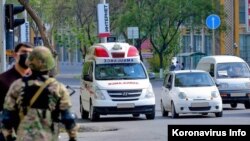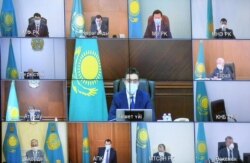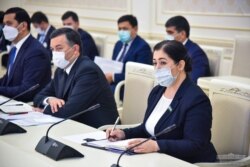While slow to take hold in Central Asia, the coronavirus is now spreading rapidly in the region, exposing weaknesses in its national health care systems and the shortcomings of its authoritarian approaches to problem-solving.
Leaders claim to be doing all they can to fight the virus, yet patients, caretakers and medics tell another story.
From sharing personal experiences with detection and treatment of COVID-19 to more clinical assessments of emergency care, Uzbeks, Kazakhs and Kyrgyz are more vocal than ever before about the failure of their governments to deliver essential services.
“The virus has shown the rot in the health care system,” said Qamariddin Shayhov, who took three tests and suffered what he described as wasteful bureaucracy as a COVID-19 patient. Shayhov is the founding director of Qalampir.uz, a Tashkent-based online media outlet.
Uzbekistan’s Health Ministry, in an acknowledgment that the system cannot accommodate all patients, has issued a manual for home treatment and is encouraging patients to go to private clinics.
“This fight must involve state and private medical care providers,” said President Shavkat Mirziyoyev. “The entire health care system must stay ready to deal with the pandemic.”
But while many Uzbeks appreciate Mirziyoyev’s calls for unity and resolve, they complain that he has not fostered effective action.
“What I’ve witnessed in our district health care system proves that whatever is said there does not move beyond meetings,” says Shayhov.
Amid promises to provide equipment and medication and to make tests accessible and timely, governments in the region have had to look abroad for technical, medical and financial aid.
Meanwhile, Central Asian countries face the risk of importing more infections as they repatriate citizens living abroad, often from countries with high infection rates. Uzbekistan has brought home nearly 100,000 citizens, many of them laborers from Russia, on charter flights and placed them in quarantine.
As of July 21, Uzbekistan – a country of 33 million – had nearly 18,000 infections and 93 deaths, with nearly 10,000 patients now recovered.
Kazakhstan, with a population of 18.3 million people, has the highest infection rate in the region with more than 73,000 cases and 585 deaths. It reports that over 45,000 patients have recovered.
Kyrgyzstan, with 6.3 million people, has the highest fatality rate with 1,079 deaths among 28,251 infected patients. Some 15,000 patients have recovered.
Tajikistan, a country of 9 million people, did not report any cases until May but now has at least 7,000 patients, 57 deaths and nearly 6,000 recovered patients.
Then there is Turkmenistan, a country of some 5.8 million people that has not reported any infections, putting it alongside North Korea with no official cases recorded.
Independent sources, such as Radio Liberty’s Turkmen Service, cite reports of acute cases of pneumonia, and a worsening health and economic situation in that country. And despite its denials, Turkmenistan has restricted transit and shopping and banned mass gatherings.
Kazakhstan President Kassym-Jomart Tokayev and his administration sounded alarms as infections rose dramatically this summer, but Tokayev pledged that the pandemic would pass. Now, he sees more hardship coming as infection rates continue to climb in urban areas.
Uzbekistan began reopening in late June when the Health Ministry was reporting just dozens of cases, but that grew in July to hundreds of cases daily. Uzbekistan’s COVID-19 task force has warned that the health care system will collapse if infections reach 1,000 to 1,500 new confirmed cases per day.
Mirziyoyev’s administration has reimplemented a strict quarantine until August 1, vowing to extend it if the exponential rise in infections in Uzbekistan does not abate.
Like Tokayev, Mirziyoyev has shifted blame to local and regional authorities. With nearly half of all infections occurring in the capital Tashkent and its environs, Mirziyoyev has scolded mayors, the governor and heads of health departments, including Tashkent’s Mayor Jakhongir Artikhodjayev and Health Minister Alisher Shodmonov.
Uzbek officials who did not want to be named told VOA that they have been given one last chance to make improvements.
Social media has exploded with charges of government ineptitude, along with widespread complaints about hospital conditions, lack of testing and drugs, corruption and mismanagement.
A former member of Uzbekistan’s parliament, Karim Bahriyev, says authorities must take responsibility instead of shifting blame.
“Who destroyed the education and the health care systems, put their irresponsible and incapable relatives in charge and stole from the budget for health care and medications? Citizens?” he asked rhetorically.
On Facebook, Bahriyev cited poor accountability by both central and local governments.
Rustam Ashurov, a young scientist, lists several reasons for Uzbekistan’s poor performance, including backward and wasteful record-keeping; lack of laboratories and testing in hospitals; misuse and under-use of medical technology and human capital; poor decision-making and execution; unhappy, underpaid medical workers; and a failure to learn from other countries’ experiences.
“Why has not our Health Ministry learned from Spanish or Italian COVID-19 experiences? We had four months to learn their lessons,” Ashurov asked on Facebook.
Governments are worried. Mirziyoyev recently instructed mayors and governors to spend hours each day on social media, responding to citizens’ concerns.
Meanwhile, economic problems proliferate, with governments relying on international financial institutions and hoping for increased assistance and investment.
Washington has allocated $25 million in medical and humanitarian aid and is boosting the regional presence of the U.S. Agency for International Development.
The World Bank has promoted its One Health approach, which seeks to establish a network of institutions, services, laboratories and professionals to jointly prevent, detect, respond to and manage outbreaks.
The bank’s Central Asia director Lilia Burunciuc said, “For One Health to take off in Central Asia, it needs investment, leadership and the engagement of member countries.”
In a July 20 blog post, she said labor migration fuels vulnerability to pandemics because “viruses freely cross borders, so the pandemic is a wake-up call to improve preparedness and surveillance.”







